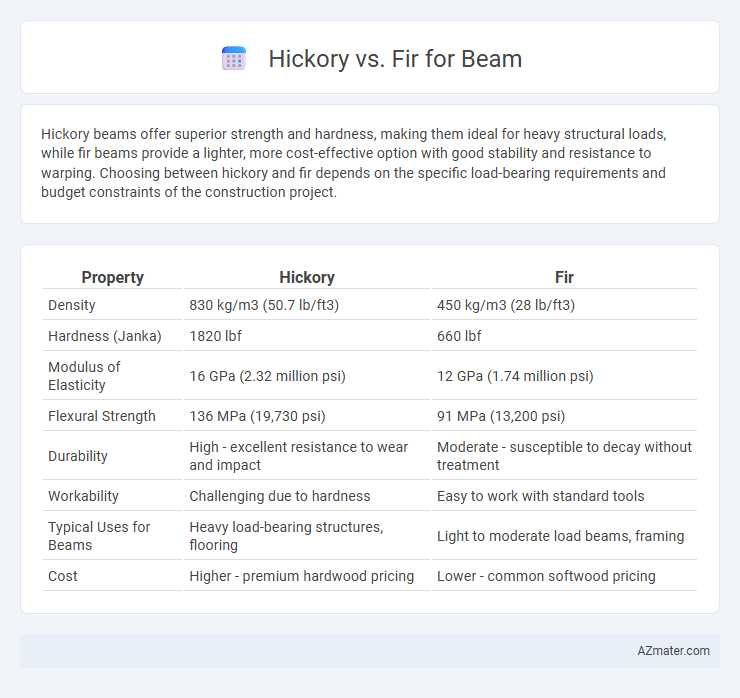Hickory beams offer superior strength and hardness, making them ideal for heavy structural loads, while fir beams provide a lighter, more cost-effective option with good stability and resistance to warping. Choosing between hickory and fir depends on the specific load-bearing requirements and budget constraints of the construction project.
Table of Comparison
| Property | Hickory | Fir |
|---|---|---|
| Density | 830 kg/m3 (50.7 lb/ft3) | 450 kg/m3 (28 lb/ft3) |
| Hardness (Janka) | 1820 lbf | 660 lbf |
| Modulus of Elasticity | 16 GPa (2.32 million psi) | 12 GPa (1.74 million psi) |
| Flexural Strength | 136 MPa (19,730 psi) | 91 MPa (13,200 psi) |
| Durability | High - excellent resistance to wear and impact | Moderate - susceptible to decay without treatment |
| Workability | Challenging due to hardness | Easy to work with standard tools |
| Typical Uses for Beams | Heavy load-bearing structures, flooring | Light to moderate load beams, framing |
| Cost | Higher - premium hardwood pricing | Lower - common softwood pricing |
Overview of Hickory and Fir as Beam Materials
Hickory beams are renowned for their exceptional hardness, strength, and shock resistance, making them ideal for heavy structural loads and applications requiring durability. Fir beams, especially Douglas Fir, provide a favorable strength-to-weight ratio with good stiffness and resistance to warping, commonly used in construction for their dimensional stability and ease of workability. Both hickory and fir offer distinct advantages, with hickory excelling in toughness and fir preferred for consistent performance in framing and beam support.
Key Differences Between Hickory and Fir Beams
Hickory beams are renowned for their exceptional density and strength, offering superior load-bearing capacity compared to fir beams, which are lighter and less dense. Fir beams, especially Douglas fir, provide excellent dimensional stability and resistance to warping, making them ideal for long spans in construction. While hickory's hardness and impact resistance make it suitable for heavy-duty applications, fir's uniform texture and ease of machining support versatile architectural uses.
Strength and Structural Properties Comparison
Hickory beams exhibit superior strength and hardness compared to fir, with a higher Janka hardness rating of about 1,820 lbf versus fir's approximate 600 lbf, making hickory ideal for applications requiring exceptional durability. Structurally, hickory also has greater bending strength and shock resistance, ensuring better performance under heavy loads and impact. Fir beams, while lighter and easier to work with, offer less compressive strength and are more prone to dents, limiting their use in high-stress structural applications.
Appearance and Grain Characteristics
Hickory beams display a striking contrast with their dark streaks and irregular grain patterns, offering a rustic, robust aesthetic ideal for statement features. Fir beams present a more uniform appearance with straight, fine grain and a lighter, reddish-brown hue that complements modern and traditional designs alike. The distinctive grain of hickory contributes to its textured, natural look, while fir's even grain ensures a cleaner, more consistent finish.
Durability and Resistance to Wear
Hickory beams demonstrate exceptional durability and resistance to wear due to their dense, hard grain structure, making them ideal for heavy-duty applications and high-traffic areas. Fir beams, while offering moderate durability and good dimensional stability, are softer and more prone to dents and scratches compared to hickory. Choosing hickory over fir ensures superior long-term performance in structural support and aesthetic longevity under consistent stress and impact.
Workability and Ease of Installation
Hickory beams offer exceptional workability due to their dense, tough grain, allowing for precise shaping and durable fastening, making them ideal for heavy-duty structural use. Fir beams provide superior ease of installation thanks to their lighter weight and straight grain, which simplifies cutting and handling on-site. The fir's moderate hardness balances strength with faster assembly, whereas hickory may require more effort but delivers longer-lasting support under high stress.
Cost and Availability Considerations
Hickory beams typically come at a higher cost due to their density and durability but offer exceptional strength and resistance, making them suitable for heavy structural use. Fir beams are generally more affordable and widely available, favored for their lightweight nature and ease of handling in construction projects. Availability varies regionally, with fir being more common in North American markets while hickory may require special sourcing, impacting both price and procurement timelines.
Environmental Impact and Sustainability
Hickory beams, sourced from slow-growing hardwood trees, offer high durability and longevity, reducing the frequency of replacement and overall environmental impact. Fir beams, typically harvested from fast-growing softwood species like Douglas Fir, promote sustainable forestry practices due to their rapid regeneration and widespread availability. Both materials support eco-friendly construction when certified by organizations such as FSC, but fir generally provides a lower carbon footprint because of quicker growth cycles and efficient resource use.
Best Applications for Hickory vs Fir Beams
Hickory beams excel in applications requiring exceptional strength and shock resistance, making them ideal for heavy-load bearing structures such as timber framing and flooring joists in high-traffic areas. Fir beams, prized for their straight grain and stability, are best suited for architectural elements where dimensional stability and ease of finishing are critical, such as window frames, door headers, and decorative exposed beams. Both woods offer durability, but hickory's density supports structural demands, while fir provides aesthetic versatility in construction projects.
Conclusion: Which is Better for Your Beam Project?
Hickory offers superior hardness and strength, making it ideal for beams requiring high durability and load-bearing capacity. Fir is more affordable and easier to work with, suitable for projects where cost and machining efficiency are priorities. Choosing between Hickory and Fir depends on the specific structural demands and budget constraints of your beam project.

Infographic: Hickory vs Fir for Beam
 azmater.com
azmater.com